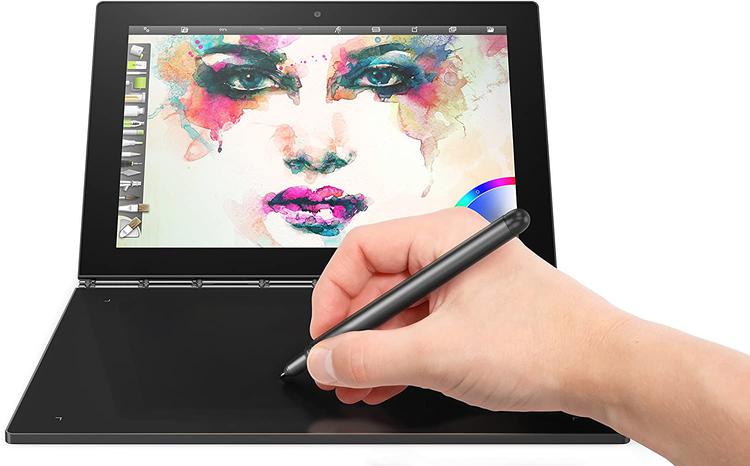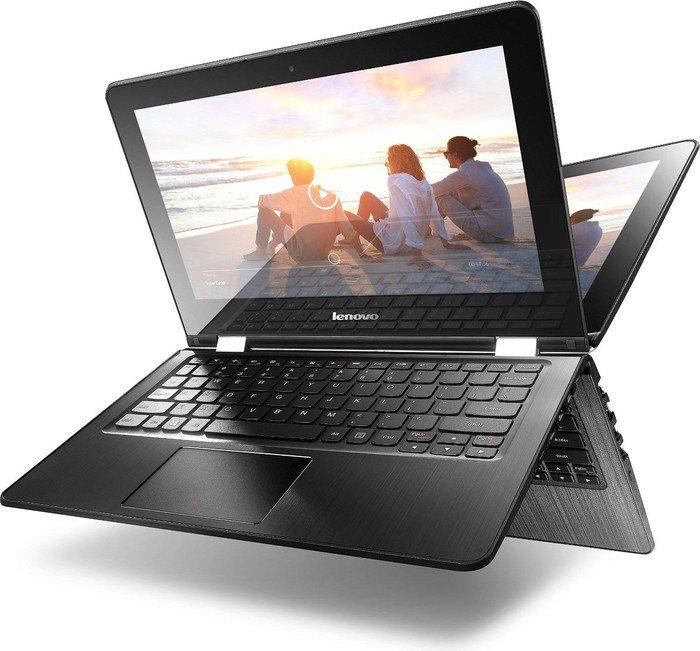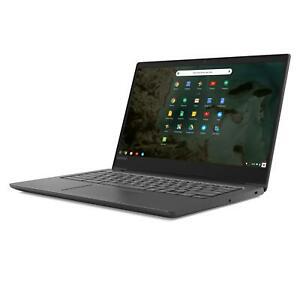Publisher's Note:
In general, we do not recommend laptops older than 2 years. See our top picks below
Best Laptops
, or answer a few simple questions in our
Laptop Finder
to receive personalized recommendations
Our verdict
The Lenovo Yoga Book is an insanely thin convertible that combines a laptop, digital sketchpad and notebook, but forget about typing on it.
To the
Super thin, ultra light chassis
lively screen
Create Pad and Real Pen deliver fluid, precise writing
Solid performance
Long battery life
Against
Difficult to type on the Halo keyboard
Cannot write on the screen with the pen
To write or not to write, that is the question here. Whether it is nobler to write on a plain pad or pen the snares and arrows that the mind suffers, or to go fully digital amidst a sea of vocabulary.
Sorry, I'm a bit literary here. But it's hard not to be with something as unique as the Lenovo Yoga Book ($549 for Windows, $499 for Android). The 0.38-inch thick convertible was designed for writers, journalists or artists, and logs all your feverish pen movements on its 10-inch screen via Lenovo's proprietary Create Pad, which doubles as the first haptic keyboard of its kind.
As new as these innovations are, they prevent the Yoga Book from functioning as a fully-fledged Windows convertible, especially when typing. Ultimately, the Yoga Book still needs some fine-tuning before the convertible of tomorrow is ready today.
Publisher's Note:
Check out our review
Lenovo Yoga Book with Android
.
draft
When it's closed, the Yoga Book looks like those expensive Moleskine notebooks I spontaneously drop $40 for when I come across it at Barnes & Noble. The black magnesium-aluminum chassis has a silky feel and just a hint of granularity. A glittering Lenovo emblem is embedded in the lower left corner, accentuating the silvery aluminum bracelet hinge that has become synonymous with the Lenovo Yoga series convertibles.
The stylish hinge not only looks great, but also lets the device lie completely flat and allows for a smooth transition between different uses such as tablet, laptop and tent.
When you open the Yoga Book, the black panel that serves as the writing and typing area becomes visible. When my hand touched the warm surface, the touch-capacitive keyboard lit up. Although the touch keyboard is interesting, my gaze at the 8- Megapixel rear camera steered in the top right corner of the deck. You'll find a 2 MP camera in the traditional position in the center of the top thick black frame surrounding the 10.1-inch display.
The Yoga Book is incredibly slim and light at 1.5 pounds and 10.1 x 6.7 x 0.38 inches. Its waifish shape made devices like the Dell Inspiron 11 3000 2-in-1 (2.8 pounds, 11.5 x 8 x 0.82 inches), the
Lenovo IdeaPad Miix 310
(2.4 pounds, 9.7 x 6.8 x 0.7 inches) and the
Microsoft Surface 3
with its Type Cover (1.95 pounds, 10.5 x 7.4 x 0.53 inches) looks chunky in comparison.
It slipped into my backpack with minimal effort and would just as easily slip into a medium-sized purse. But honestly, I just liked carrying it in my hands as it made me feel more like a writer.
MORE:
Our favorite tablets for work and play
With such a thin frame, there isn't much room for ports, but Lenovo managed to squeeze a micro-USB, micro-HDMI, and microSD card slot on the Yoga Book's left side. On the right side are the buttons for power and volume with a combined headphone/microphone connection.
Advertisement
The Yoga Book's 1920 x 1200 IPS touch display is colorful and bright, but the tones could be more accurate. Actor Denzel Washington's typically bronzed skin appeared darker than usual on the 10.1-inch panel in the 1080p Fences trailer .But it wasn't enough to distract from the actor's liberal scattering of fine white hair throughout his beard and hairline.
The Yoga Book's panel reproduced 101 percent of the sRGB color space, which is excellent. It beat the 95 percent ultraportable average, as well as the 99, 84, and 56 percent results of the Surface 3, Miix 310, and Inspiron 11 3000.
Color accuracy left a lot to be desired, however, with the Yoga Book scoring 5.2 on the Delta-E test, well above the 0 ideal and the 2.1 average. The Inspiron 11 3000 and Surface 3 both came in at 3.8 and 3.1 respectively, but the Miix 310 proved to be the most accurate at 0.8.
You can never call the Yoga Book a dim light bulb, as the convertible averaged 343 nits in our brightness test, beating the category average of 301 nits. Although the Miix 310 (255 nits) and Inspiron 11 3000 (208 nits /m²) were significantly darker, the Surface 3 outshone everything with 407 cd/m².
Audio
For such a slim body, the Yoga Book gets surprisingly loud. Additionally, the audio is surprisingly clear, as I discovered when listening to Chris Stapleton's "Tennessee Whisky." The singer's smoky vocals combined with the gentle strumming of the acoustic and bass guitars The Dolby Audio software definitely made for a better listening experience. Out of the six settings (Dynamic, Movie, Music, Game, Voice, and Personalize), Dynamic delivered the best audio overall.
Keyboard and Touchpad: Not for touch typists
I'm someone who lives and dies by the Home row keys. I even took a keyboard class in high school. So it's pretty much ingrained in my brain that my fingers tend to curl up when they're on A, S, D, F and J, K, L rest before I start typing. But with the Yoga Book's Halo touch-capacitive keyboard, that's almost impossible.
The moment I took the typing position to write this review in Google Docs, I unleashed a volley of gibberish that only Cthulhu would understand. This meant I had to resort to the hunt-and-peck method, which is good for an email or maybe for taking notes during a meeting, but nothing more.
On the 10fastfingers typing test, I managed to pick out 25 words per minute, which is well below my typical 65 wpm. While my typing method definitely affected my score when typing, the proximity of the keys to each other and the sensitivity of the keyboard also played a role. There were many times where my fingers would hover too close to a key, causing it to appear off the page. It would have been nice to offer a sensitivity adjustment setting, but unfortunately Lenovo didn't offer one. However, you can adjust the brightness of the keyboard , adjust the strength of the haptic feedback and the key tone.
The keyboard isn't a total disaster. When I manage to hit the right key, I appreciate the strong haptic feedback. It makes up for the lack of key travel and actuation typically found on a regular keyboard. I appreciate those too Ability to perform Windows shortcuts such as cut (CTRL + X), copy (CTRL + C), paste (CTRL + V) and lock screen (CTRL + ALT + DEL).
The 2.6 x 1.3-inch touchpad is on the small side for my liking. There were way too many times where I accidentally swiped my finger on the spacebar, which yielded tactile goodness, but not the scrolling action that I expected. The two side edges did their job well for the right and left mouse buttons. Still, it's very uncomfortable not having the mouse buttons under the touchpad like on every other laptop.
If the Yoga Book were a few inches taller (let's say 12 inches), there would be more room overall to give the keys and touchpad the correct spacing.
My pad and my pen
The typing experience on the Yoga Book isn't the best, but writing is like a well-oiled machine. When you're not awkwardly typing an email on the keyboard, it can be turned into a handy notepad that holds all your notes, doodles, and can capture doodles.
Beneath the hard, unforgiving keyboard is a proprietary feature Lenovo calls the Create Pad. It's basically a Wacom digitizer, turning your analog creations into a digital format. The onboard digitizer supports up to 2,048 levels of pressure sensitivity with a 100- Degree angle detection. Activating Create Pad is as simple as pressing the pencil icon next to the camera on the keyboard deck.
But all this fancy tech is nothing without input means. For that, Lenovo offers its Real Pen, which can transform from a stylus into a real ballpoint pen in those cases where you want a hard copy of your work. To switch from pen to pen ( and vice versa), just use the hole at the top of the pen cap to loosen the pen tip and slide one of the three mini ballpoint pen tips into the vacant space. In other words, don't lose the pen cap.
When it's time to put a real pen to paper, Lenovo has you covered with the Book Pad. Essentially a fancy notepad attached to a magnetized holder, the pad pairs perfectly with the embedded digitizer. When you're out of paper If you have more, you can replace it with any A5 pad (5 x 8 x 8.3 inches).
The joys of writing
Call me old school, but there's something exhilarating about the act of writing. The feeling of the ink pouring out of the pen and recording your thoughts down to the last dot just feels right. However, in this high-tech world, sometimes it makes more sense to just typing my notes on my phone. That's why I love the idea of the yoga book. It lets me stay connected to my writing while recording it digitally.
In practice, writing on the Book Pad is like writing in a higher quality notebook. The paper is nice and thick and the ink from the mini ballpoint pen tip produces smooth, even lines. But more importantly, the screen that sits above the digitizer positioned, kept up with my imperfect handwriting, and matched every open a, unsplit t, and undoped i.
I wrote most of it in the OneNote mobile app, as it launches automatically when pen mode is on. It did a solid job of recording everything I wrote on the Book Pad and linking it to my OneDrive account synchronize.
In addition to OneNote, the Windows version of Yoga Book offers several pen-friendly programs under the Windows Ink Workspace, including Sticky Notes, Sketchpad, and Screen Sketch. Sticky Notes is like a digital post-it note that comes in handy for reminders.
For people who are more artistic than me, Sketchpad provides basic drawing tools to create an impromptu masterpiece. I managed to make a passable sketch of a sunset over the water. Similar to many smartphones, Screen Sketch captures a Image of the display so you can write or draw on the resulting image.
The Windows Store has a number of pen-supported programs in its library, including Graphiter, Notebook Pro, and Sketchable, which offer more robust writing and drawing experiences.
What is missing
I decided to check out the Windows version of the Yoga Book for its productivity potential. The ability to have my handwritten sticky notes recorded in OneNote is definitely helpful. I also enjoy taking notes on the screen, especially during meetings. I have that though Feeling that the Android version is the way to go when it comes to features. I was disappointed to learn that the Windows version of the Yoga Book can't take notes when the screen is off. Another interesting omission is the ability to use the pen to write directly on the screen.
perfomance
The Yoga Book's 2.4GHz Intel Atom x5-Z8550 processor with 4GB of RAM won't set the world on fire. However, you can take notes, watch a movie, or draw a sketch or two. I got one Watched an episode of Luke Cage on Netflix with eight tabs open in Google Chrome before noticing any latency.
In our synthetic Geekbench 3 test, the Yoga Book produced 3,412. The Surface 3 and its 1.6GHz Intel Atom x7-Z8700 weren't too far behind at 3,351. The Miix 310 (1.4GHz Intel Atom x5-Z8350 CPU) and the Inspiron 11 3000 (2.2 GHz Intel Core m3-6Y30 CPU) lacked the necessary performance with 2445 and 2345 points, respectively.
The Yoga Book's 64GB eMMC flash drive (expandable to 128GB via the microSD slot) duplicated 4.97GB of mixed media files in 2 minutes and 57 seconds. That's a transfer rate of 28.8 Megabytes per second, which beats the Inspiron 11 3000 (500GB 5400rpm HDD) at 27.2MB/s. However, the Miix 310, which also has a 64GB eMMC drive, hit 36 .7 Mb/s, while the Surface 3 (128 GB eMMC drive) delivered 36.7 Mb/s.
During the OpenOffice spreadsheet macro test, the Yoga Book matched 20,000 names and addresses in 13 minutes and 27 seconds, beating the Surface 3's 13:31 and the Miix 310's 16:55. The Inspiron 11 3000 finished the task with a quick 6:16.
Equipped with an Intel HD 400 Graphics GPU, you can play a range of casual games on the Yoga Book, but not much more. In the 3DMark Ice Storm Unlimited graphics test, the convertible scored 24,615 points, which was enough to overpower the Miix 310's Intel HD Graphics GPU and toppling its score of 17,451. The Surface 3's Intel HD Graphics GPU edged out the Yoga Book with 24,840. But the Inspiron 11 3000 with its Intel HD Graphics 515 GPU was the ultimate winner with 42,354.
battery life
Lenovo claims the Yoga Book can last up to 13 hours on a single charge. However, when we ran our battery test, which consists of continuous web surfing over Wi-Fi, the hybrid died at 9 hours and 35 minutes.

MORE:
10 tablets with the longest battery life
However, that was more than enough to beat the 8-hour class average of ultraportables, the Surface 3 at 8:01 and the Inspiron 11 3000 at a below-average 5:30. The Miix 310 came in at a time of 12:24 the last standing convertible.
heat
No matter what we throw at it, the Yoga Book stayed cool under pressure. Fifteen minutes after streaming a full-screen HD YouTube video, the Yoga Book's touchpad and the distance between the G and H keys measured 82 and 85 degrees Fahrenheit, respectively .The bottom of the convertible was a bit hotter at 96 degrees, which is just above our 95-degree comfort threshold.
cameras
In case you want to take a photo or video, the Yoga Book has double coverage with its 2MP and 8MP cameras on the front and back of the device. Both cameras offer an HDR mode, so your Deliver images with rich colors and sharp contrasts in difficult lighting conditions.
The reversing camera did a pretty good job of detail, as I could see the dome lights twinkling from my colleague's hair. However, his red and gray striped shirt took on a pink hue, with the camera blending the two colors.
The front camera did a better job with the color, accurately depicting my bright orange sweater and the ribbing in the turtleneck portion of the shirt. It even managed to capture my deep purple locks.
software and warranty
Aside from the sketching and note-taking apps, the Yoga Book has the usual Windows 10 apps, with several third-party programs including Netflix, Pandora, and Twitter. You also get a few games like Candy Crush Soda Saga and Farmville 2: Country Escape.
configurations
The Windows version of the Yoga Book costs $549 and comes with a 2.4GHz Intel Atom x5-Z8550 processor with 4GB of RAM, a 64GB eMMC flash drive and an Intel HD 400 Graphics GPU supplied. The Android version of the device has the same specs and costs $499.
bottom line
The Yoga Book is the futuristic convertible I want across the board. Lenovo definitely gets points for taking a risk and creating such a bold product. The Yoga Book's super-thin, super-light chassis is the dream come true , while the Halo keyboard is straight out of a sci-fi novel. The Create Pad gives you a realistic pen feel.
However, as innovative as the keyboard is, it makes using the convertible as a laptop quite difficult. It would also have been nice if you could take notes on the Windows version of the Yoga Book with the screen off, just like on the Android model.
If you're willing to shell out $500 or more for a second device that you use primarily for recording or sketching, the Yoga Book can come in very handy. If you're not connected to the Windows ecosystem, consider the Android version of this device that costs $50 less. It also has some useful proprietary software and note-taking works with the screen off.
If you want a primary device that you can type on and use for many different purposes, consider the discontinued but still available device
Microsoft Surface 3
or
Lenovo IdeaPad Miix 310
.The Windows version of the Yoga Book is innovative and compelling, but this hybrid isn't quite ready for prime time.
More on laptops
Best Laptops Under $500
Best HP Laptops
Best Samsung Laptops
Lenovo Yoga Book (Windows) Specifications
Bluetooth
Bluetooth 4.0
brand
Lenovo
CPU
2.4 GHz Intel Atom x5-Z8550 processor
card slots
microSD
corporate website
www.lenovo.com
screen size
10.1
graphic card
Intel HD 400 graphics
disk size
64GB
hard drive speed
n / A
disk type
eMMC
native resolution
1920x1200
operating system
Windows 10 Home
optical drive
none
Optical drive speed
n / A
Connections (except USB)
Micro HDMI, Micro USB, headphone/microphone
R.A.M.
4GB
size
10.1 x 6.7 x 0.38 inches
touchpad size
2.6 x 1.3 inches
USB ports
1
Weight
1.5 pounds
Wireless Internet access
802.11a/b/g/n/ac
WiFi model
Broadcom 802.11ac
Fewer
Sherry L Smith
Sherri L. Smith has been creating product reviews for Laptopmag.com since 2011. In that time, she's reviewed more than her share of laptops, tablets, smartphones, and everything in between. Resident gamer and audio junkie Sherri was previously senior editor for Black Web 2.0 and a contributor to BET.Com and Popgadget.




